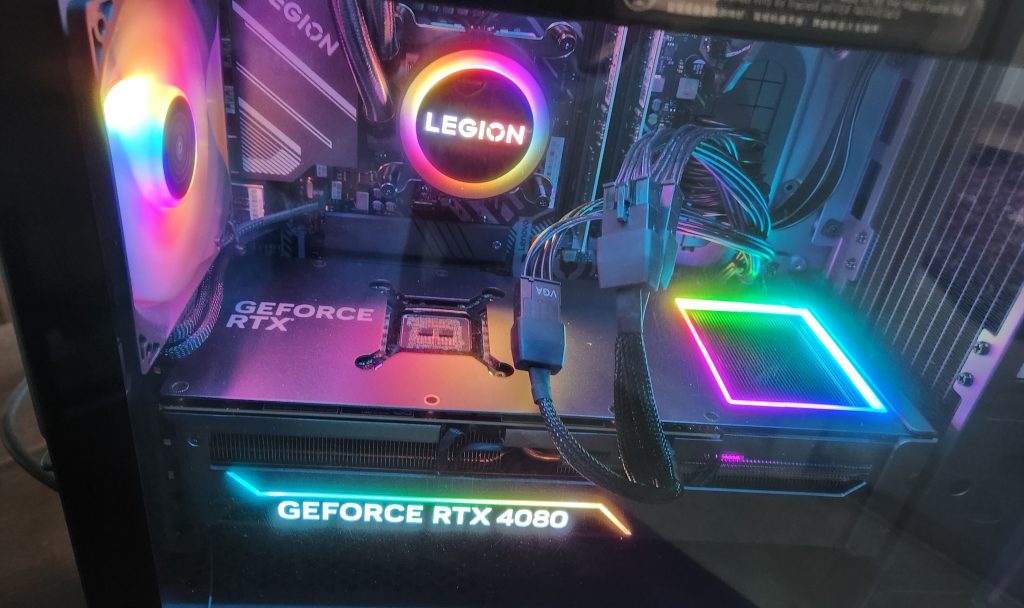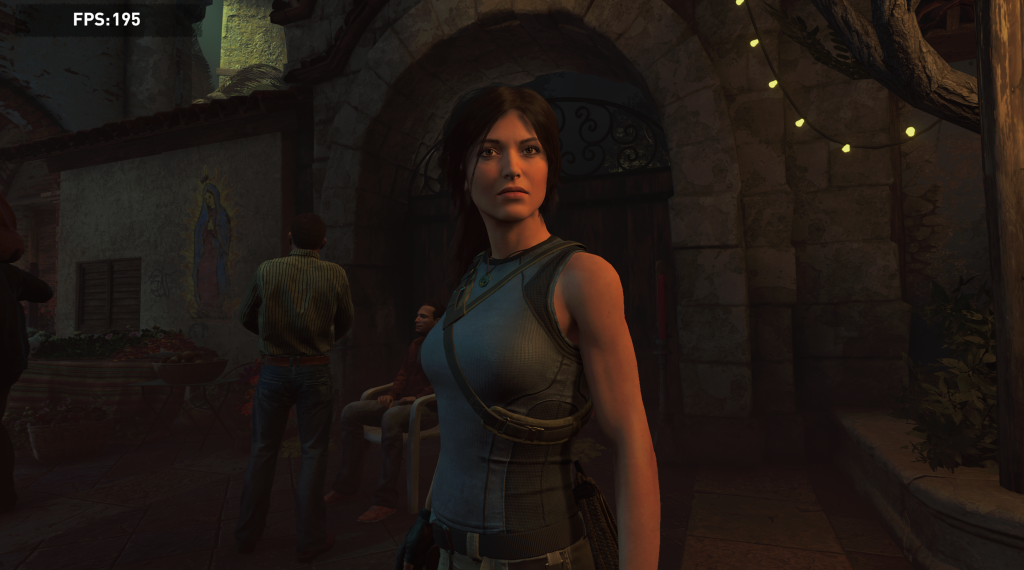For those that prefer the power of desktop grade cards and have your very specific and fastidious gaming or streaming setup, we have a desktop from Lenovo for you – the Legion 7i Gen 8. Available with up to i9’s and RTX 4090’s, these can be tuned up to be absolute powerhouses. And we have something in that beastly line for our tests:
- OS: Windows 11 Home [Pro available]
- Processor: 13th Generation Intel® Core™ i9-13900KF Processor (E-cores up to 4.30 GHz P-cores up to 5.40 GHz with Turbo Boost, 24 Cores, 32 Threads, 36 MB Cache)
- Memory: 32GB DDR5 5600MHz [up to 64 available]
- Graphics: NVIDIA® GeForce RTX™ 4080, 16GB
- Storage: 1TB PCIe SSD Gen 4 [up to 2TB avaiable]
- Connectivity: WiFi 6E 802.11AX (2×2), RJ45 Ethernet, Bluetooth 5.1
 Out of the box this seems like a compact tower, but has the weight that represents the power inside. At 37.48lb, this 34L tower measures in at 19.37″ x 8.31″ x 18.27″, which ain’t bad at under 20 inches tall to fit under a desk. It has a clean “storm grey” finish all the way around with a honeycomb front panel and window on the left side to enjoy the light show. Lenovo’s own ARGB lighting system allows for customization for internal ambient, rear fan, video card, liquid cooling block and front panel with a variety of options, including more diagnostic options like lighting based on temperature. The LED brightness is pretty good, letting you decide whether you want a basic static glow or a rainbow wheel at every turn.
Out of the box this seems like a compact tower, but has the weight that represents the power inside. At 37.48lb, this 34L tower measures in at 19.37″ x 8.31″ x 18.27″, which ain’t bad at under 20 inches tall to fit under a desk. It has a clean “storm grey” finish all the way around with a honeycomb front panel and window on the left side to enjoy the light show. Lenovo’s own ARGB lighting system allows for customization for internal ambient, rear fan, video card, liquid cooling block and front panel with a variety of options, including more diagnostic options like lighting based on temperature. The LED brightness is pretty good, letting you decide whether you want a basic static glow or a rainbow wheel at every turn.
 One thing I love about desktops is how much they’re expandable. The T7 has 3 internal PCIe slots (3.0, 4.0, and 5.0) and 4 x M.2 slots (one for WLAN, three for SSD). In addition to the expandability inside, there’s a near ridiculous number of ports on the outside. The front has 2 x USB-A 3.2 Gen 1’s (5Gbps), 2 x USB-A 2.0’s and the headphone/mic jack on the top. The rear has some serious variety for additional peripherals: 4 x USB-A 3.2 Gen 1’s (5Gbps), a USB-A 3.2 Gen 2 (10Gbps), a USB-C 3.2 Gen 2 (20Gbps), 2 x USB-A 2.0’s, 6 x audio I/O, and and RJ45 for 2.5G gigabit ethernet.
One thing I love about desktops is how much they’re expandable. The T7 has 3 internal PCIe slots (3.0, 4.0, and 5.0) and 4 x M.2 slots (one for WLAN, three for SSD). In addition to the expandability inside, there’s a near ridiculous number of ports on the outside. The front has 2 x USB-A 3.2 Gen 1’s (5Gbps), 2 x USB-A 2.0’s and the headphone/mic jack on the top. The rear has some serious variety for additional peripherals: 4 x USB-A 3.2 Gen 1’s (5Gbps), a USB-A 3.2 Gen 2 (10Gbps), a USB-C 3.2 Gen 2 (20Gbps), 2 x USB-A 2.0’s, 6 x audio I/O, and and RJ45 for 2.5G gigabit ethernet.
This says nothing of the power inside, featuring Intel processors up to the Raptor Lake i9-13900KF, which is a 24 core processor, paired with NVIDIA RTX cards up to a 4090. We have the i9 with a 4080, and as you will see in the next session, there was nothing I could do to make this thing try hard. It stayed quiet the entire time, and I never had to worry about a temperature spike.
Performance
Absolute power.
PCMark 10: Our standard benchmark for office applications gave us a 8,598 (Essentials 10,883, Productivity 8,937, Digital Content Creation 17,734), beats all the gaming laptops we’ve taken a look at. The big takeaway is the digital content creation score which blows away laptops by over 50% performance, which comes with the power of a desktop grade card.
3DMark Time Spy: Time Spy gave us an 23,383 showing DirectX performance right in line with a high end gaming PC. It was so strong we also were able to run Time Spy Extreme, which gave us 13,050, beating other high-end gaming desktops.
3DMark Port Royal: This ray-tracing test came back with a 16.823, beating the high end gaming desktops by a good margin.
3DMark Night Raid: You know, just for fun. 85,664 as expected from a high end gaming desktop.
Procyon Photo/Video Editing: The test for Adobe Photoshop and Lightroom gave us a 10,002, and we got a 5,688 for testing Adobe Premiere Pro. This is a massive score for photo editing, and the one surprise for our battery of tests was what we felt was a low-ish score for video editing.
 Shadow of the Tomb Raider: FOUR. K. ALL. DAY. The T7 and its 4080 made this benchmark child’s play. You can follow Lara’s exploits in 4K, with the ray tracing turned all the way to ultra, with DLSS on performance, and still get an experience above 100fps. Massive.
Shadow of the Tomb Raider: FOUR. K. ALL. DAY. The T7 and its 4080 made this benchmark child’s play. You can follow Lara’s exploits in 4K, with the ray tracing turned all the way to ultra, with DLSS on performance, and still get an experience above 100fps. Massive.
- FHD / highest: 226 fps
- FHD / highest with ultra ray tracing: 205 fps
- 2560×1600 / highest: 189 fps
- 2560×1600 / highest with ultra ray tracing: 140 fps
- 4K / highest: 188 fps
- 4K / highest with ultra ray tracing: 140 fps
 Final Fantasy XV: This entire test can be summed up with the phrase “extremely high.” Noctis and his comrades ran through this test easily, with the only setting dropping from extremely high being 4k with graphics turned up. And what did it drop to?.
Final Fantasy XV: This entire test can be summed up with the phrase “extremely high.” Noctis and his comrades ran through this test easily, with the only setting dropping from extremely high being 4k with graphics turned up. And what did it drop to?.
Very high.
- FHD / standard graphics: 22,989 – extremely high
- FHD / high graphics: 20,574 – extremely high
- 2560×1440 / standard graphics: 21,911 – extremely high
- 2560×1440 / high graphics: 17,670 – extremely high
- 4K / standard graphics: 12,804 – extremely high
- 4K / high graphics: 10,729 – very high
 Madness. This was the first system we’ve tested where every single test from bottom to top scored in the 5 figures in Final Fantasy XV. We also took a tour of our XBOX library with Ghostwire: Tokyo, which looked fantastic. As for things like our Blizzard library – no reason to even test with the performance we’re seeing.
Madness. This was the first system we’ve tested where every single test from bottom to top scored in the 5 figures in Final Fantasy XV. We also took a tour of our XBOX library with Ghostwire: Tokyo, which looked fantastic. As for things like our Blizzard library – no reason to even test with the performance we’re seeing.
Overall
Lenovo’s Intel-based Legion T7 tower can be made to be an absolute monster. We got the highest scores we’ve ever gotten on this machine, and those would only go up if we had the 4090 model. The specs come at a price though, with an i7/4080 model starting at about $2900 (on sale at Lenovo for less atm) which isn’t bad, seeing as an RTX 4080 card on its own can run upwards of $1,400. As for the unlocked i9 in our review model? $500 more. The T7 comes with those pieces already inside of a heavy duty case.
It’s a lot of machine that I had a tough time trying to tax from any angle. It’ll do what you need and then some.




